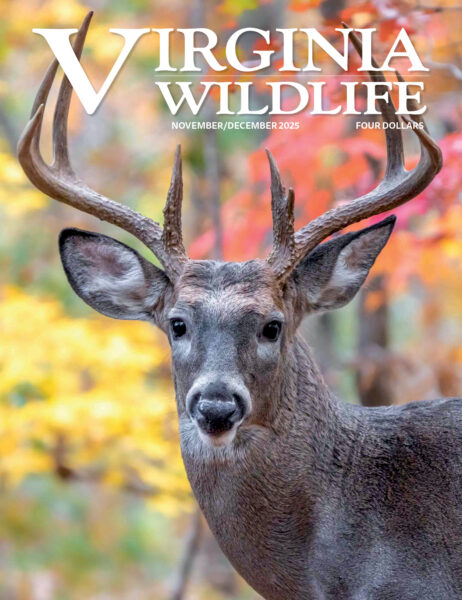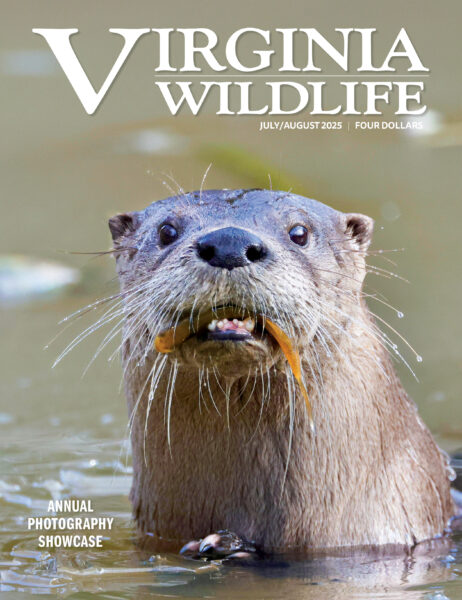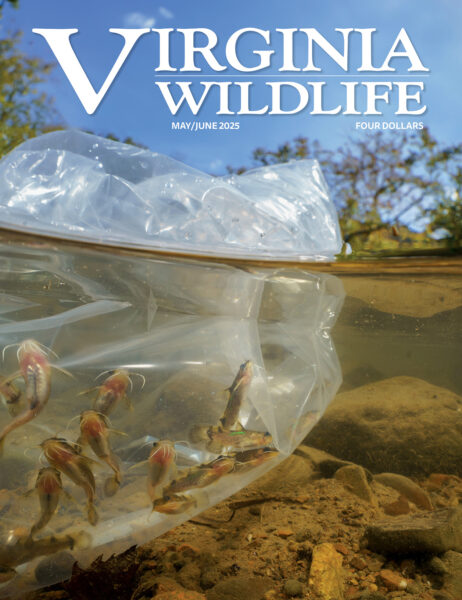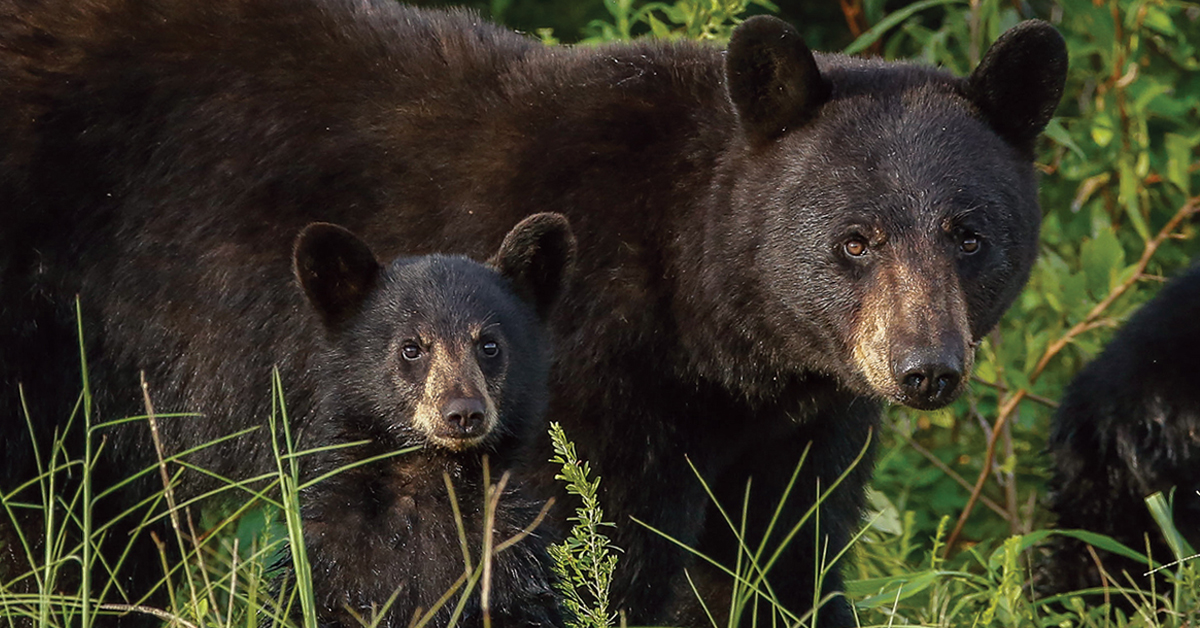
The collaring project not only enable biologists to place orphaned cubs with female bears, but also give insight into how bears use resources. Photo by Paul McCroskey
By Stephanie Simek and Katie Martin / DWR
How GPS collars are helping orphaned bear cubs and improving biologists’ understanding of bears in Virginia’s Piedmont region.
Imagine being a mother, waking up from a nap, and discovering that another child to care for had showed up in your house while you were asleep. You shrug, welcome that child, and raise it as your own. That’s what happens to some of the bears in the Virginia Department of Wildlife Resources (DWR) bear-collaring program, where orphaned bear cubs are placed in the dens of female bears identified as foster mothers.
DWR’s bear-collaring project in the Piedmont region of Virginia has proven to be a remarkably successful strategy for releasing orphaned bear cubs back into the wild by fostering them with a female bear wearing a collar equipped with global positioning satellite (GPS) technology. But the GPS collars that help DWR biologists find and track potential foster mothers for orphaned cubs have also opened up new fields of research and data to continue learning about how bears live in the Piedmont region, the foothills of the Blue Ridge Mountains.
Virginia was one of the leading states for black bear research and recovery in the 1980s and ’90s, with research efforts focused on the mountainous areas of the state. The bear-collaring project has helped build that knowledge for the bears of the Piedmont region as the bears have expanded their range into this area. It’s helping biologists learn how they use this landscape versus what’s been learned in the past in the mountains of Virginia.
The bear-collaring project started in 2016 with an objective of fostering wild orphan bear cubs with female bears already raising cubs. Other eastern states (Maine, Pennsylvania, New York) had reported success with fostering cubs, and even Virginia, during early work in Shenandoah National Park, had some success with fostering a few cubs. In Virginia, orphan bear cubs can either be fostered on a wild den or rehabbed by The Wildlife Center of Virginia (the only permitted rehabilitation center for black bears in Virginia) then returned to the wild as yearlings.
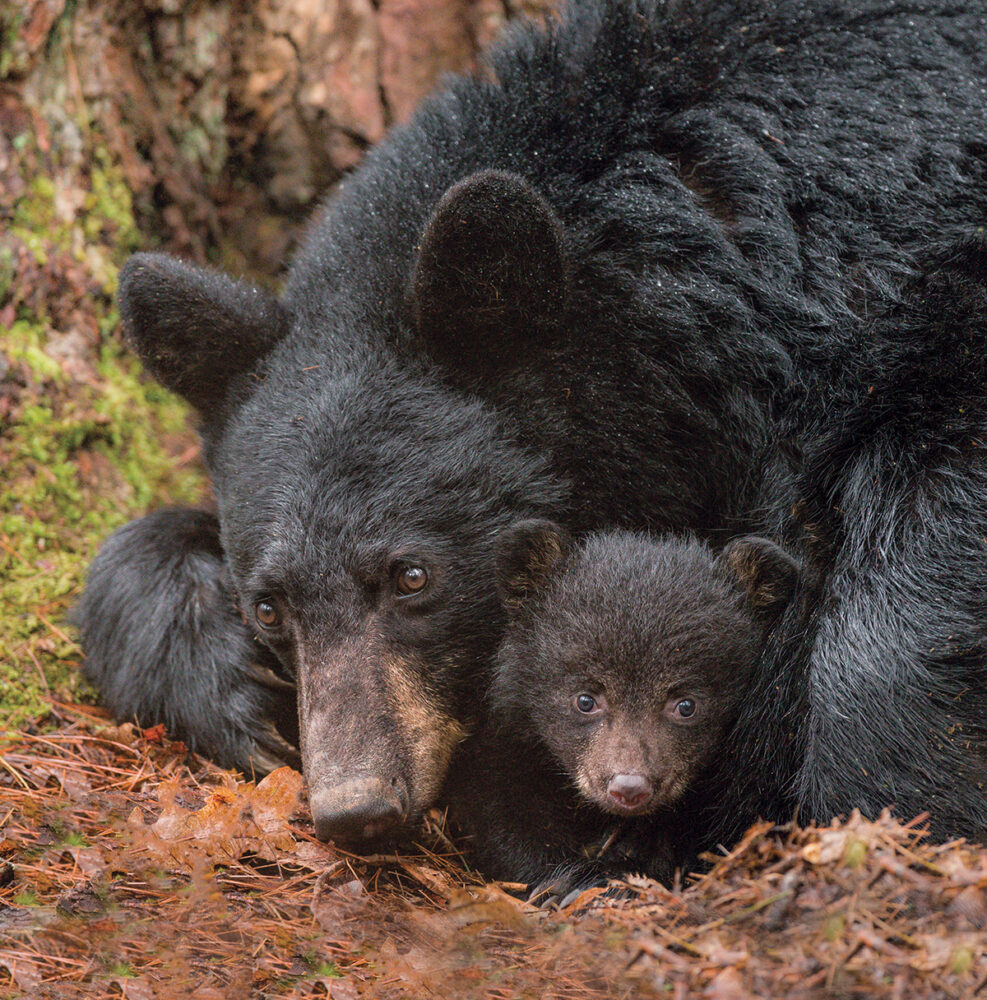
A female bear protectively cradles one of her young cubs in the spring forest. Photo by Bill Lea
The preference is to return these cubs back to the wild with a wild female bear as soon as possible since much of their development is dependent on what their mother teaches them. Prior to the collaring project, finding a female bear den was like looking for a needle in a haystack! The GPS collars inform biologists of the location of a female bear’s den site, enabling them to drop off an orphan cub to the den of a female bear already raising cubs.
In the process, biologists realized that the valuable location information they were gathering from the collars could help them branch off of that original goal and look at home range, denning ecology, and reproduction of bears in the Piedmont region, which had not been studied before. DWR biologists are hoping to also use the collar data to discover new information about resource selection, or what and where bears eat, and how they use their habitat.
The Collaring Process
There are currently nine bears in the Piedmont region of Virginia wearing collars that actively transmit data via GPS. When radio-collaring bears first started in the 1980s, the collars used VHF technology, which required biologists to roam the woods with an antenna looking for a collar’s signal a few times a week to create location data for a bear.
With GPS collar technology, the collar collects a location data point every four hours and then sends that data to a satellite system every three days. Biologists can pull that data from the system through a web-based link to locate bears and track their movement. The GPS data is not only much quicker, but also far more accurate. The batteries for the collars used in this research last for two years, and the collar is designed to fall off the bear at the end of the battery’s life. Biologists then locate the collar, have it refurbished with new materials including a new battery, and re-use it. The bears don’t seem to mind wearing the collars.
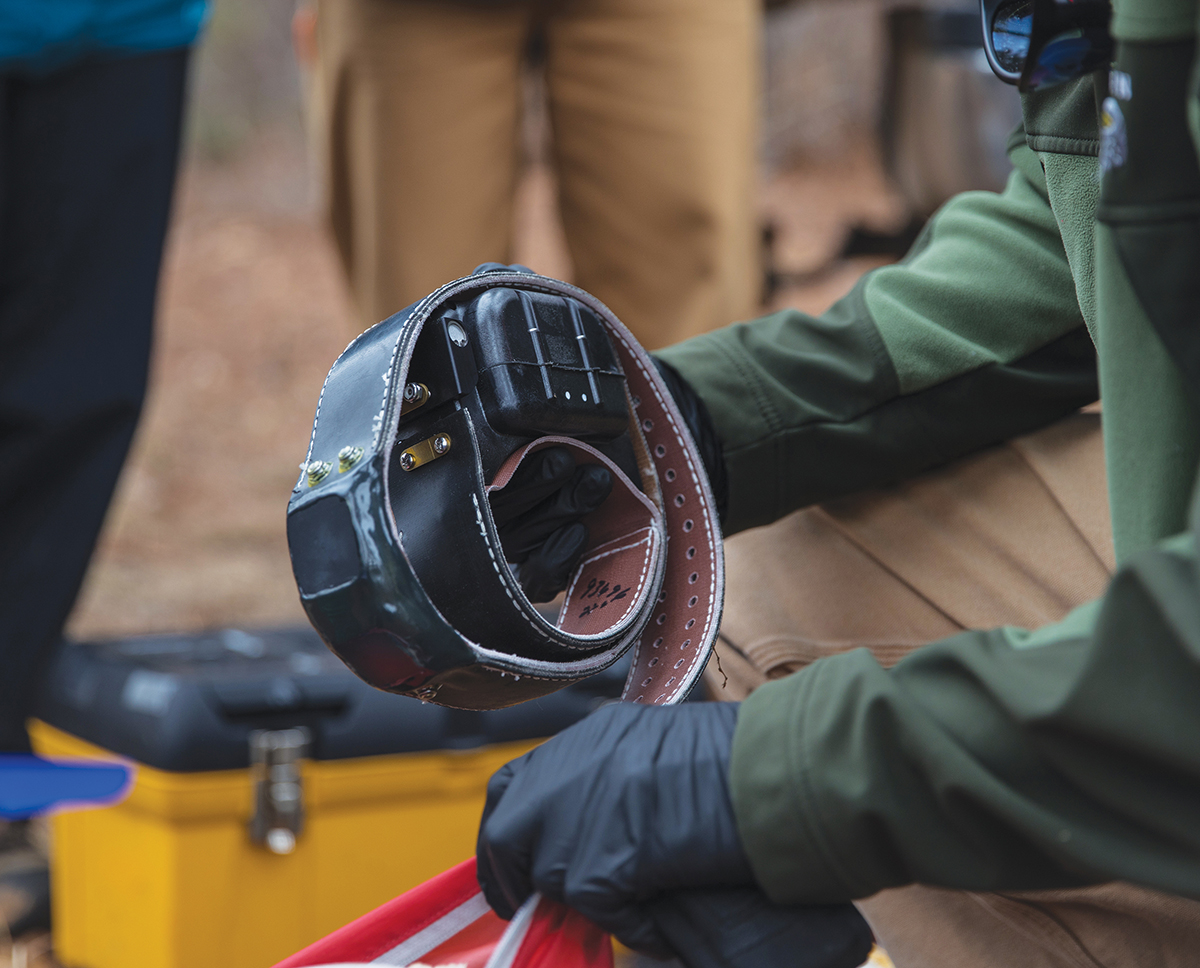
One of the GPS collars. Photo by Meghan Marchetti / DWR
Biologists identify female bears that are of breeding age (3½ years and over) and more than 100 pounds as candidates for the collaring project. During the summer, when the bears are breeding and searching for food, biologists will capture the bear in a specially designed humane trap that’s essentially a section of large culvert pipe with doors on each end. The trap is baited, and has bedding inside.
Once biologists determine a captured bear is female and a candidate for the collaring program, they chemically immobilize the bear with a sedative administered via a syringe on the end of a pole. Then a team of two or three people remove the bear from the trap and check all the vital signs—heart rate, respiration, temperature. They administer oxygen and take measurements of neck and girth circumference and collect hair and tick samples, then place the GPS collar on the bear. The process takes about 30 minutes.
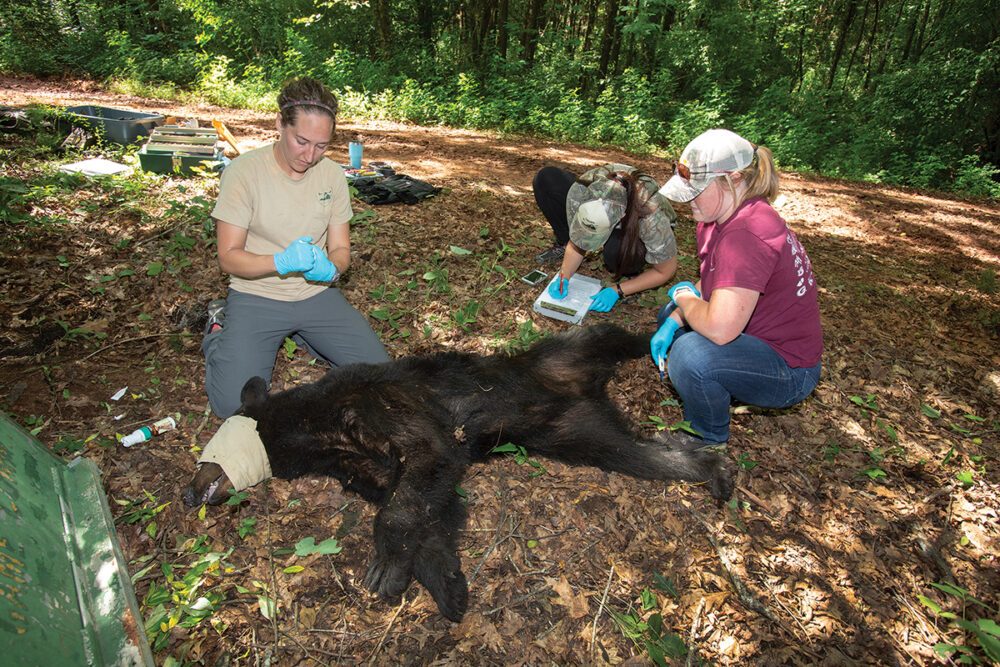
Before placing a collar on a sedated female bear, DWR biologists check the bear’s health. Photo by Lynda Richardson / DWR
Throughout the entire process, one person is assigned the task of monitoring the bear’s vital signs to ensure the bear’s health. The bear is administered supplemental oxygen during the time it’s immobilized to provide adequate respiration. DWR biologists go to great lengths to ensure the safety and health of the animal, using a methodology that’s recognized as one of the best in the country.
When the process is complete, the biologists administer a reversal agent that wakes the bear up, then the biologists back away from the immediate area and watch as the bear wakes up and leaves. Because the collar begins transmitting immediately, biologists can track the bear and make sure its movements don’t indicate any problems after handling the animal.
Fostering Success
The orphan bear cub fostering efforts have been successful, with nine cubs having been fostered with GPS-collared females since 2016. Each year, biologists watch the data from GPS-collared females, determine which ones have cubs, and locate their dens. They then make an informed decision about if a certain female bear is suitable to take on another cub.
If so, sometimes they can go in and just drop the cub off in the den without any kind of work-up or immobilization of the female. Other times they might need to change the female’s collar out or gather some more information, so they will immobilize the female and do a full work-up at that time. When she wakes up, the new cub will be there. Thankfully the female bears are very agreeable about taking on another cub and the process is usually successful.
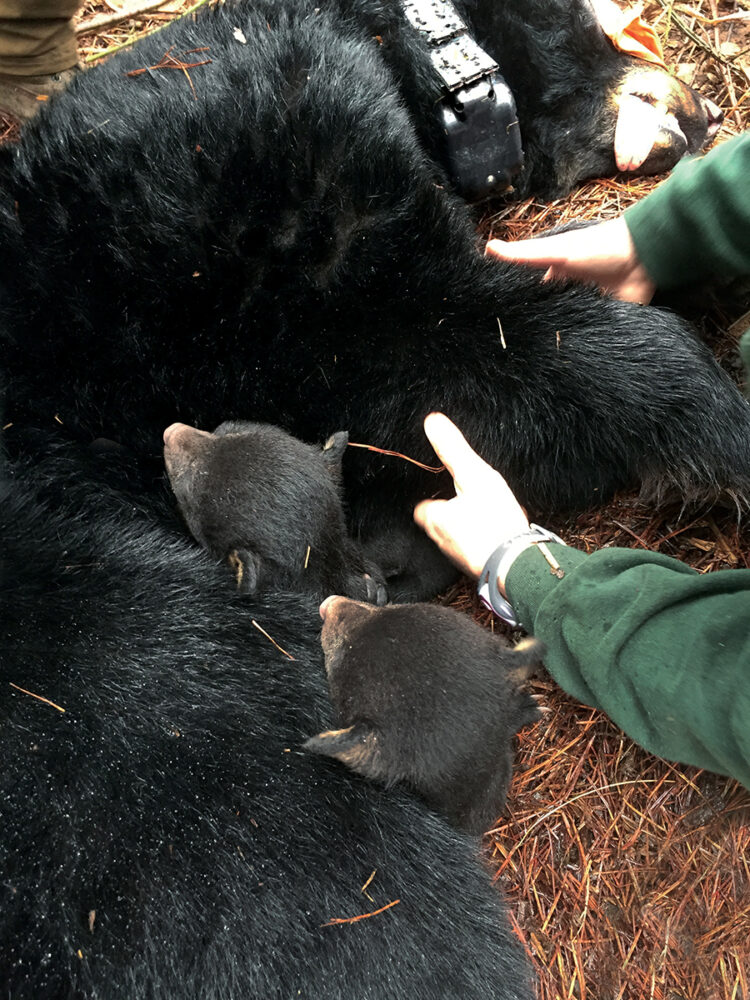
After sedation and collar placement on this female bear, the natal cub and a newly introduced orphan cub were placed together. Photo courtesy of Garet Bosinger
There are two female bears that DWR biologists have used in the fostering program twice. Their excellent body condition and willingness to raise cubs make them ideal candidates. The very first bear collared in 2016 was re-captured and re-collared in 2019. She has successfully raised cubs twice during the time DWR has been monitoring her.
In the summer of 2020, DWR biologists successfully placed three orphan cubs with three foster females, but there are 20 more orphan cubs currently undergoing rehabilitation and care at The Wildlife Center of Virginia that will be released in summer 2021 as yearling bears. Timing is critical when it comes to fostering orphan cubs and unfortunately many cubs are “orphaned” too late in the year to be successfully placed on a wild den.

This tiny bear cubs was taken to The Wildlife Center of Virginia after a family dog brought it home to surprised owners. The cub was fed around the clock until it could be fostered with a female bear that is part of the DWR collaring program. Photo courtesy of The Wildlife Center of Virginia
One essential part of solving the problem of orphan bear cubs is informing the public that if they see a bear cub in the wild, not to disturb it. If you see a very small cub, do not try to remove it from the area or “save it.” When sensing danger, a female bear will typically send her cubs up a tree or leave them at the base of a tree and leave the area to draw the danger away from where her cubs are located. These trees are commonly known as “babysitter trees.” In such cases, the female will usually return to gather up the cubs when no people or pets are around, usually after dark. As the cubs get older and are more mobile, it is common for a female bear to leave her cubs to go forage as much as two miles away from them.
A female bear will again reunite with her cubs when there is no indication of danger.
Understanding More
As DWR biologists work to update their bear management plan, they’ll be carefully looking at what else the data from the GPS collars tells them. Preliminary study of the data shows somewhat different movement from bears in the Piedmont than might have been expected. For example, Piedmont region bears have a delayed denning season com-pared to bears in the mountain regions, denning at the end of December and emerging in mid- to late March.
The den selection itself, what they’re using as a den site, is quite a bit different than what’s been seen in the mountain areas. Much of it is based on the environmental factors of what’s available for them as a resource for denning, as well as weather conditions and food sources on the landscape. The elevation is different, the habitat is different, and those kinds of components contribute to bears’ denning behavior.
In addition, data suggests that the bears are more active even during the denning period than previously believed. DWR biologists set up a trail camera outside a collared female’s den and observed her moving around all through February. The bear had four cubs (three natal cubs and one fostered cub) in her den, and she was never truly asleep after about February 14. DWR biologists have been surprised by and interested in these behaviors. The Piedmont region offers bears abundant food resources, which means bears may not need to travel far to acquire food resources, and biologists are seeing location information from the bears that reflects that, with smaller home ranges for bears in the Piedmont.
The collar data will also help biologists understand how the bears are using the area’s food resources through-out the year and how it varies when there are particular mast crop failures or anomalies in the resources that are available. Some of the bears that have been “on air” with collars for multiple years have provided data about how they shift movement and patterns at different times of the year and during different catastrophic events, like a mast crop failure. With the GPS collar providing numerous points a day, the data is fairly accurate and very consistent, helping biologists to really see how bears are using the landscape even within a 24-hour period versus a week period.
Future study of the data can provide even more information about how the bears are using their resources, even to the point of doing site-specific looks at locations where bears were spending three or four hours and better under-standing what plant species they’re utilizing. That kind of information would be key in helping to shape DWR’s landscape management within the bears’ range.
What does the future hold for the bear-collaring project? It’s possible that future GPS collars will also feature cameras, enabling DWR biologists to even better understand how the bears of the Piedmont region use their landscape.
For more information about black bears in Virginia, please visit the DWR bear page. For more advice about living responsibly with black bears, visit bearwise.org.
Dr. Stephanie Simek served as DWR’s Black Bear Project Leader, while Katie Martin is the co-lead and statewide Deer, Bear, and Turkey Biologist for the agency.
A Few Black Bear Facts
♦ Female bears are called sows, male bears are called boars
♦ Sows are sexually mature as early as 3 years
♦ Breeding occurs mid-June to mid-July
♦ Cubs are born in January or early February
♦ Cubs are born nearly hairless and weigh 6-12 ounces
♦ Anywhere from 1-4 cubs are born at a time
♦ The sow will care for cubs about 11/2 years
♦ Mortality rate for first-year cubs is about 20 percent, primarily due to predation, abandonment by their mother, or displacement

This article originally appeared in Virginia Wildlife Magazine.
For more information-packed articles and award-winning images, subscribe today!
Learn More & Subscribe



